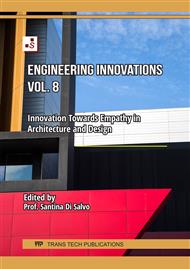[1]
A.M. Rizwan, Y.C.L. Dennis, & C.A. Liu, A review on the generation, determination and mitigation of Urban Heat Island. Journal of Environmental Sciences, 20(1), (2007) 120–128
DOI: 10.1016/S1001-0742(08)60019-4
Google Scholar
[2]
P. Shahmohamadi, A.I. Che-Ani, I. Etessam, K.N.A. Maulud, & N.M. Tawil, Healthy Environment: The Need to Mitigate Urban Heat Island Effects on Human Health. Procedia Engineering, 20, (2011) 61-70
DOI: 10.1016/j.proeng.2011.11.139
Google Scholar
[3]
X. Li, Y. Zhou, S. Yu, G. Jia, H. Li, & W. Li, Urban heat island impacts on building energy consumption: A review of approaches and findings. Energy, 174, (2019) 407-419
DOI: 10.1016/j.energy.2019.02.183
Google Scholar
[4]
J.F. Bastin, E. Clark, T. Elliott, S. Hart, J. van den Hoogen, I. Hordijk, H. Ma, S. Majumder, G. Manoli, J. Maschler, L. Mo, D. Routh, K. Yu, C.M. Zohner, & T.W. Crowther, Understanding climate change from a global analysis of city analogues. Plos One, 14(10), e0224120. (2019)
DOI: 10.1371/journal.pone.0224120
Google Scholar
[5]
D. Spano, V. Mereu, V. Bacciu, S. Marras, A. Trabucco, M. Adinolfi, G. Barbato, F. Bosello, M. Breil, M.V. Chiriacò, G. Coppini, A. Essenfelder, G. Galluccio, T. Lovato, S. Marzi, S. Masina, P. Mercogliano, J. Mysiak, S. Noce, J. Pal, A. Reder, G. Rianna, A. Rizzo, M. Santini, E. Sini, A. Staccione, V. Villani, & M. Zavatarelli, Analisi del rischio. I cambiamenti climatici in Italia. DOI: 10.25424/CMCC/ANALISI_DEL_RISCHIO (2020)
DOI: 10.5194/egusphere-egu2020-19285
Google Scholar
[6]
C. Wickham, R. Rohde, R. Muller, J. Wurtele, J. Curry, D. Groom, R. Jacobsen, S. Perlmutter, A. Rosenfeld, & S. Mosher, Influence of Urban Heating on the Global Temperature land average using rural sites identified from MODIS classifications. Geoinformatics & Geostatistics An Overview, 1(02), (2013) 1-14
DOI: 10.4172/2327-4581.1000104
Google Scholar
[7]
J.E. Hardy, D. Mitlin, & D. Satterthwaite, Environmental problems in an urbanizing world. London: Earthscan Publishers. ISBN: 9781315071732 (2001)
Google Scholar
[8]
H. Akbari, C. Cartalis, D. Kolokotsa, A. Muscio, A.L. Pisello, F. Rossi, M. Santamouris, A. Synnefa, N. Wong, & M. Zinzi, Local climate change and urban heat island mitigation techniques – the state of the art. Journal of Civil Engineering and Management, 22(1), (2016) 1-16
DOI: 10.3846/13923730.2015.1111934
Google Scholar
[9]
M. Santamouris, & D. Kolokotsa, (Eds.), Urban Climate Mitigation Techniques (1st ed.). London: Routledge. DOI: 10.4324/9781315765839 (2016)
Google Scholar
[10]
S. Mahmutaj, G. Kalli, E. Mersini, & M. Buxhaku, Analysis of the urban heat island effect in the city of Tirana, Albania. Bulletin of Engineering Geology and the Environment, 72(4), (2013) 425-432.
Google Scholar
[11]
Municipality of Tirana, Adapting our City to a Changing Climate. Vulnerability Assessment and Adaptation. Action Plan for Tirana. Tirana: Intergrafika. ISBN: 978-9928-4249-7-6 (2015)
Google Scholar
[12]
United Nations General Assembly (UN-GA), Transforming our world: the 2030 Agenda for Sustainable Development (Report A/RES/70/1). https://www.un.org/en/development/desa/population/migration/generalassembly/docs/globalcompact/A_RES_70_1_E.pdf (2015)
Google Scholar
[13]
Information on https://www.instat.gov.al/ INSTAT (2023)
Google Scholar
[14]
Information on https://www.testo-direct.com/pdfs/cache/www.testo-direct.com/0632-1535/ datasheet/0632-1535-datasheet.pdf (2023)
Google Scholar
[15]
K. Xhexhi, Climate Parameters, Heat Islands, and the Role of Vegetation in the City. In: K Xhexhi (Ed.), Ecovillages and Ecocities, 2023 pp.149-170. The Urban Book Series. Springer, Cham
DOI: 10.1007/978-3-031-20959-8_6
Google Scholar
[16]
K. Xhexhi, Ecovillages and Ecocities. Bioclimatic Applications From Tirana, Albania; Springer Cham; ISBN: 978-3-031-20959-8; DOI: https://doi.org/10.1007/978-3-031-20959-8 (2023)
DOI: 10.1007/978-3-031-20959-8_1
Google Scholar
[17]
S. Dervishi, E. Lacaj, & R. Vathi, Urban heat islands (UHI) mitigation in densely urban city of Tirana, Albania: Materials, energy, comfort. International Journal of Business and Technology, (2012). 1(1), 6
DOI: 10.33107/ijbte.2012.1.1.06
Google Scholar
[18]
V. Picari, & S. Dervishi, Analysis of Urban Heat Island Phenomenon and Mitigation Strategies for Tirana, Albania. In V. Corrado, E. Fabrizio, A. Gasparella, & F. Patuzzi (Eds.), Proceedings of the 16th IBPSA Conference, 2-4 September, Rome, (2019) 3786- 3793. Rome: International Building Performance Simulation Association
DOI: 10.26868/25222708.2019.211334
Google Scholar
[19]
A.T. Panariti, A. Maliqari, & P. Tashi, The Impact of Urban Texture in Outdoor Thermal Comfort. International Journal of Science and Research, (2015) 4(12).
Google Scholar
[20]
E. Dervishi, F. Gjoka, S. Karaj, J. Dervishi, & E. Gjata, Urban heat island in Tirana city: characteristics, consequences and mitigation strategies. International Journal of Civil Engineering and Technology, 9(11), (2018) 1822-1832.
Google Scholar
[21]
B. Brestovci, A. Beqiraj, A. Kukaj, E. Sula, & L. Kamberi, The impact of urbanization on the urban heat island effect: A case study of Tirana, Albania. Fresenius Environmental Bulletin, 28(5), (2019) 3605-3613.
Google Scholar
[22]
F. Aimar, Limiting Soil Sealing and Depaving: Local Actions for Regenerating Public Spaces to Build Green Infrastructures. In B. Giudice, G. Novarina, & A. Voghera (Eds.), Green Infrastructure, Planning Strategies and Environmental Design (2023) 127-137. The Urban Book Series. Cham: Springer
DOI: 10.1007/978-3-031-28772-5_11
Google Scholar
[23]
L. Battisti, F. Aimar, G. Giacco, & M. Devecchi, Urban Green Development and Resilient Cities: a First Insight into Green Space Planning in Italy. Sustainability, 15(15), (2023) 12085. DOI: 10.3390/su151512085 (peer reviewed)
DOI: 10.3390/su151512085
Google Scholar
[24]
A.S. Onyango, Urban Health, Africa, climate change mitigation, risk and crisis management, urban resilience. Urbanet. https://www.urbanet.info/urban-heat-pollution-resilience-planning/ (2022)
Google Scholar
[25]
P.J. Marcotullio, C. Keßler, & B.M. Fekete, The future urban heat-wave challenge in Africa. Exploratory analysis. Global Environmental Change, Volume 68 (2021) 102219
DOI: 10.1016/j.gloenvcha.2020.102190
Google Scholar


